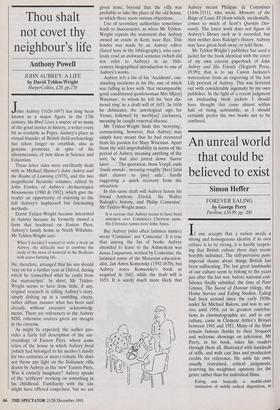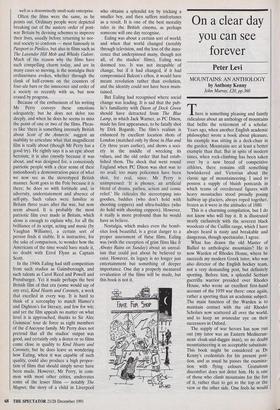An unreal world that could be believed to exist
Simon Heller
FOREVER EALING by George Perry Pavilion, £10.99, pp. 200 If one accepts that a nation needs a strong and homogenous identity if its own culture is to be strong, it is hardly surpris- ing that British culture these days seems horribly indistinct. The still-pervasive post- imperial shame about things British has been suffocating. The last great landmarks of our culture seem to belong to the years just after the last war, before national con- fidence finally subsided: the time of Peter Grimes, The Sword of Honour trilogy, the Home Service and Ealing Studios. Ealing had been around since the early 1930s, under Sir Michael Balcon, and was to sur- vive until 1956; yet its greatest contribu- tions to cinematographic art, and to our culture, came in Clement Attlee's Britain between 1945 and 1951. Many of the films remain famous thanks to their frequent and welcome showings on television. Mr Perry, in his book, takes his readers through them all, illustrated with hundreds of stills, and with cast lists and production credits for reference. He adds his own, usually restrained, critical judgments, reserving his weightiest opinions for the genre rather than for individual films: Ealing was basically a middle-class institution of mildly radical disposition, as
well as a determinedly small-scale enterprise.
Often the films were the same, as he points out. Ordinary people were depicted breaking out of the austere order of post- war Britain by devising schemes to improve their lives, usually before returning to nor- mal society to conform — most famously in Passport to Pimlico, but also in films such as The Lavender Hill Mob and Whisky Galore. Much of the reason why the films have such compelling charm today, and are in many cases so moving, is the nostalgia their ordinariness evokes, whether through the clank of half-crowns on the counters of four-ale bars or the innocence and order of a society so recently with us, but now erased by progress.
Because of the enthusiasm of his writing Mr Perry conveys these emotions adequately; but he does not delve too deeply, and when he does he seems to miss the point of one or two of the films. Phras- es like 'there is something intensely British about Scott of the Antarctic' suggest an inability to articulate what that magnificent film is really about (though Mr Perry has a good try). He rightly says it is an epic about heroism; it is also (mostly because it was about, and was designed for, a consciously patriotic people with a clear sense of their nationhood) a demonstration-piece of what we now see as the stereotyped British manner. Scott goes to the Pole because it is there; he does so with fortitude and, in adversity, understatement and absence of self-pity. Such values were familiar in Britain three years after the war, but now seem absurd. It is probably the most patriotic film ever made in Britain, which alone is enough to explain why, for all the brilliance of its script, acting and music (by Vaughan Williams), a certain sort of person finds it risible. It is instructive, for the sake of comparison, to wonder how the Americans of the time would have made it, no doubt with Errol Flynn as Captain Scott.
In the 1940s Ealing had stiff competition from such studios as Gainsborough, and such talents as Carol Reed and Powell and Pressburger. Yet it made perhaps the best British film of that era (some would say of any era), Kind Hearts and Coronets, a work that excelled in every way. It is hard to think of a screenplay to match Hamer's and Dighton's for literacy, and few for wit; and yet the film appeals no matter on what level it is approached, thanks to Sir Alec Guinness' tour de force as eight members of the d'Ascoyne family. Mr Perry does not pretend that all the studios' output was good, and certainly only a dozen or so films come close in quality to Kind Hearts and Coronets; but he does leave us wondering how Ealing, when it was capable of such quality, could also produce a high propor- tion of films that should simply never have been made. However, Mr Perry, in com- mon with most other critics, underrates some of the lesser films — notably The Magnet, the story of a child in Liverpool
who obtains a splendid toy by tricking a smaller boy, and then suffers misfortunes as a result. It is one of the best morality tales in the British cinema, as perhaps someone will one day recognise.
Ealing was about a certain sort of world; and when that world changed (notably through television, and the loss of the inno- cence that underpinned many, though not all, of the studios' films), Ealing was doomed too. It was not incapable of change, but if it had changed, if it had compromised Balcon's ethos, it would have meant revolution rather than evolution, and the identity could not have been main- tained.
But Ealing had recognised where social change was leading. It is sad that the pub- lic's familiarity with Dixon of Dock Green should have detracted from The Blue Lamp, in which Jack Warner, as PC Dixon, made his first appearance, to be fatally shot by Dirk Bogarde. The film's realism is enhanced by excellent location shots of London (matched only by those in Hue and Cry three years earlier), and shows a soci- ety in the middle of wrecking its values, and the old order that had estab- lished them. The shock that went round England when PC Dixon was shot was to no avail; too many policemen have been shot, for real, since. Mr Perry is unimpressed: 'It is phoney, an artificial blend of drama, pathos, action and comic relief.' He ridicules the stereotyping into goodies, baddies (who don't hold with shooting coppers) and ultra-baddies (who do hold with shooting coppers). However, it really is more profound than he would have us believe.
Nostalgia, which makes even the bomb- sites look beautiful, is a great danger to a proper assessment of these films. Ealing was (with the exception of grim films like It Always Rains on Sunday) about an unreal- ism that could just about be believed to exist. However, its legacy is no longer just entertainment but something of deeper importance. One day a properly measured revaluation of the films will be made, but this book is not it.











































































































 Previous page
Previous page